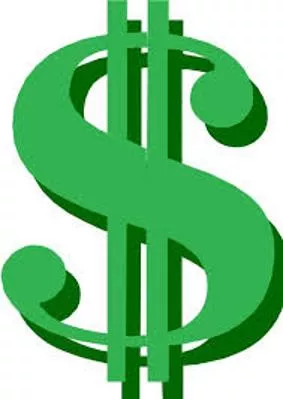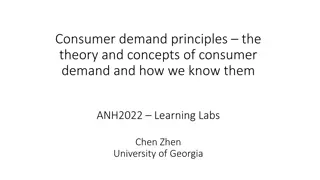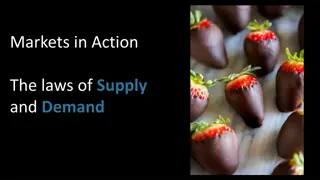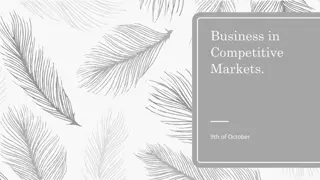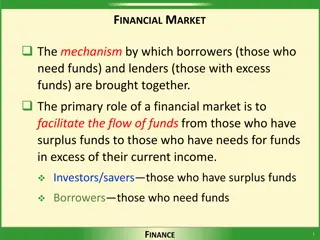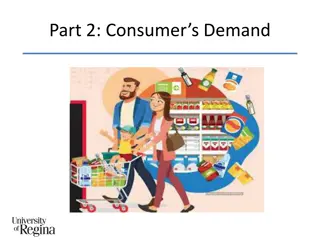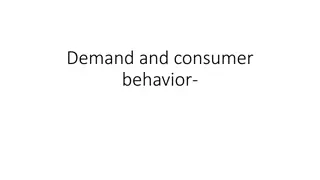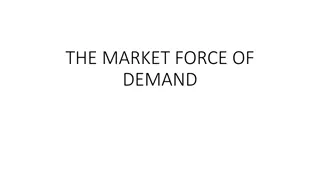Understanding Markets: Demand and Consumer Behavior
Explore the concepts of demand, consumer behavior, and the factors influencing purchasing decisions in markets. Covering topics such as the law of demand, individual demand curves, marginal utility, and overcoming obstacles to buying, this educational material delves into the intricacies of supply and demand dynamics. Understand how prices, consumer preferences, and income levels shape market behaviors and decision-making processes.
Download Presentation

Please find below an Image/Link to download the presentation.
The content on the website is provided AS IS for your information and personal use only. It may not be sold, licensed, or shared on other websites without obtaining consent from the author. Download presentation by click this link. If you encounter any issues during the download, it is possible that the publisher has removed the file from their server.
E N D
Presentation Transcript
Unit 2 Understanding Markets CHAPTERS 4, 5, & 6 honors
Demand CHAPTER 4
What is Demand? LESSON 1
Discussion Question Think about something you have been wanting to buy. What is its price? At what price would you be willing to buy the item? Pg.102
An Introduction to Demand A. Demand is the desire, ability, and willingness to buy a product. B. An individual demand curve illustrates how the quantity that a person will demand varies depending on the price of a good or service. C. Economists analyze demand by listing prices and desired quantities in a demand schedule (chart). When the demand data is graphed, it forms a demand curve with a downward slope. turn
The Law of Demand A. The Law of Demand states that the quantity demanded of a good or service varies inversely with its price. When price goes up, the quantity demanded goes down; when price goes down, the quantity demanded goes up. B. A market demand curve illustrates how the quantity that all interested persons (the market) will demand varies depending on the price of a good or service.
Discussion Question What could be a consumer s obstacle to buying?
Demand and Marginal Utility A. Marginal utility is the extra usefulness or satisfaction a person receives from getting or using one more unit of a product. B. The principle of diminishing marginal utility states that the satisfaction we gain from buying a product lessens as we buy more of the same product.
Fear of Buying 1. How does an individual's income affect his or her spending habits? 2. What can retailers do to increase demand when people are spending less? 3. Given consumers' mood during the recession in the United States, what can be done to give consumers confidence and/or decrease their fear of buying?
Demand Price Quantity Demanded Make a Demand Curve 30 0 25 0 Pg.107 1&2 20 1 15 3 10 5 5 8
Market Demand Curve Firm A Firm B Price Quantity Demanded Price Quantity Demanded 30 0 30 0 25 0 25 1 20 1 20 2 15 3 15 3 10 5 10 5 5 8 5 7
Factors Affecting Demand LESSON 2 PG.108
Discussion Question Imagine you have a weekly budget for groceries. When you shop one week, certain items you needed were on sale, and after you paid the cashier, you had $20 left. What would you do with the extra money?
Change in the Quantity Demanded A. The change in quantity demanded shows a change in the amount of a product purchased when there is a change in price. pg. 109 B. The income effect means that as prices drop, consumers are left with extra real income. C. The substitution effect means that price can cause consumers to substitute one product with another similar but cheaper item.
Change in Demand A. A change in demand is when people buy different amounts of the product at the same prices. As a result, the entire demand curve shifts-to the right to show an increase in demand or to the left to show a decrease in demand for the product. Therefore, a change in demand results in an entirely new curve.
B. A change in demand can be caused by a change in income, tastes, a price change in a related product (either because it is a substitute or complement), consumer expectations, and the number of buyers. pg.110
Global Demand Impact on Food Prices 1. How does global demand for more food affect the price of corn and soybeans? 2. How do bad weather and higher fuel prices affect the price of food? 3. Food prices continue to climb, and consumer wages remain flat. What affect does this have on food purchases?
Effects on Demand What is a new product or service that has gained popularity in the past few years? (one or multiple) Why is it in high demand? Do you think the demand for this product or service will last? For how long? What do you think will be in high demand in the future? (let s say approx. 20 years from now)
Elasticity of Demand LESSON 3
Demand Elasticity A. Elasticity measures how sensitive consumers are to price changes. B. Demand is elastic when a change in price causes a large change in demand. (luxury) C. Demand is inelastic when a change in price causes a small change in demand. (necessary) D. Demand is unit elastic when a change in price causes a proportional change in demand. pg. 116 & 117
The Total Expenditures Test A. Price times quantity demanded equals total expenditures. Price of product x Quantity = total expenditures B. Changes in expenditures depend on the elasticity of a demand curve if the change in price and expenditures move in opposite directions on the curve, the demand is elastic; if they move in the same direction, the demand is inelastic; if there is no change in expenditures, demand is unit elastic. C. Understanding the relationship between elasticity and profits can help producers effectively price their products.
Determinants of Demand Elasticity Demand is elastic if the answer to the following questions are yes. A. Can the purchase be delayed? Some purchases cannot be delayed, regardless of price changes. B. Are adequate substitutions available? Price changes can cause consumers to substitute one product for a similar product. C. Does the purchase use a large portion of income? Demand elasticity can increase when a product commands a large portion of a consumer s income.
Total Expenditures Practice Amazon shows that for every e-book sold at $14.99, it would sell 1.74 copies if priced at $9.99. For 100,000 units offered, therefore, the haul would be $1.5 million at $14.99 and $1.74 million at $9.99. Is this elastic, inelastic, or unit elastic?
A concert venue can sell either 800 tickets for $15 or 600 tickets for $20. What type of elasticity is this? Is it better to sell them for $15 or $20?
Determinants of Elasticity Chart Consumer Good or Service Can the purchase be delayed? Are there adequate substitutes? Does the purchase use a large portion of income? Type of elasticity? Quart of milk Fix broken AC Unit McDonalds Homecoming Ticket Gas for car Taxes/Bills Souvenir at a theme park
1. Do you think it should be illegal to raise the price on certain inelastic goods? Like what and why? 2. Give me an example of an elastic item you have bought in the past week. How much would you be willing to pay for that item if it kept getting more expensive? What about the same for an inelastic item?

 undefined
undefined


 undefined
undefined undefined
undefined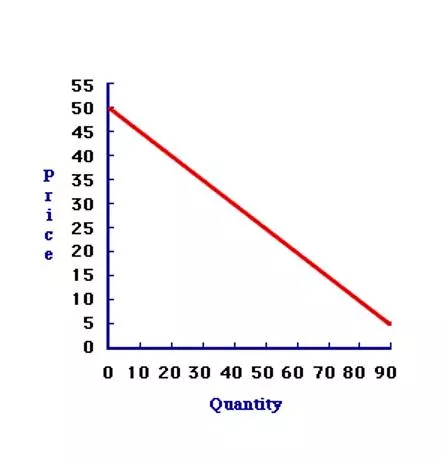
 undefined
undefined

